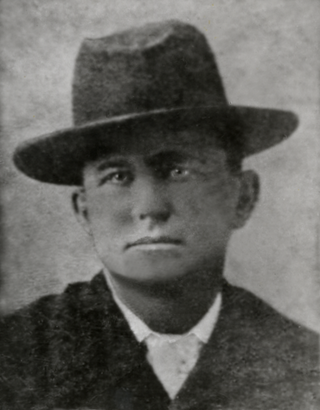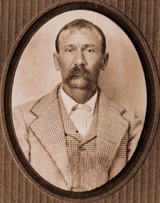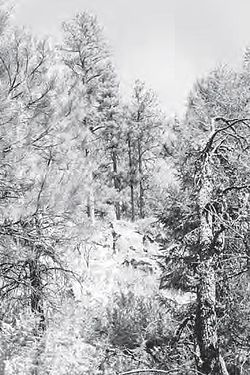
William Brocius, better known as Curly Bill Brocius, was an American gunman, rustler and an outlaw Cowboy in the Cochise County area of the Arizona Territory during the late 1870s and early 1880s. His name is likely an alias or nickname, and some evidence links him to another outlaw named William "Curly Bill" Bresnaham, who was convicted of an 1878 attempted robbery and murder in El Paso, Texas.

Joseph Isaac Clanton was a member of a loose association of outlaws known as The Cowboys who clashed with lawmen Wyatt, Virgil and Morgan Earp as well as Doc Holliday. On October 26, 1881, Clanton was present at the Gunfight at the O.K. Corral in the boomtown of Tombstone, Arizona Territory but was unarmed and ran from the gunfight, in which his 19-year-old brother Billy was killed.

Newman Haynes Clanton, also known as "Old Man" Clanton, was a cattle rancher and father of four sons, one of whom was killed during the Gunfight at the O.K. Corral. Two of his sons were involved in multiple conflicts in Cochise County, Arizona Territory including stagecoach robbery and cattle rustling. His son Ike Clanton was identified by one witness as a participant in the murder of Morgan Earp. Billy Clanton and Ike were both present at the Gunfight at the O.K. Corral in which Billy was killed. "Old Man" Clanton was reportedly involved with stealing cattle from Mexican ranchers and re-selling them in the United States. Records indicate he participated in the Skeleton Canyon Massacre of Mexican smugglers. In retaliation, Mexican Rurales are reported to have ambushed and killed him and a crew of Cowboys in the Guadalupe Canyon Massacre.

The Earp Vendetta Ride was a deadly search by a federal posse led by Deputy U.S. Marshal Wyatt Earp for a loose confederation of outlaw "Cowboys" they believed had ambushed his brothers Virgil and Morgan Earp, maiming the former and killing the latter. The two Earp brothers had been attacked in retaliation for the deaths of three Cowboys in the Gunfight at the O.K. Corral on October 26, 1881. From March 20 to April 15, 1882, the federal posse searched southeast Cochise County, Arizona Territory for the men they believed were responsible for the attacks on Virgil and Morgan. Several suspects had been identified and were charged, but were soon released by the court, owing in some cases to legal technicalities and in others to the strength of alibis provided by Cowboy confederates. Wyatt hoped that the legal system would bring the Cowboys to justice, but after suspects in both ambushes were freed, Wyatt resolved to take matters into his own hands.

Harvey Alexander Logan, also known as Kid Curry, was an American outlaw and gunman who rode with Butch Cassidy and the Sundance Kid's infamous Wild Bunch gang during the late 19th and early 20th centuries. Despite being less well-known than his fellow gang members, he has since been referred to as "the wildest of the Wild Bunch", having reputedly killed at least nine law enforcement officers in five shootings and another two men in other instances. He was involved in numerous shootouts with police and civilians and participated in several bank and train robberies with various gangs during his outlaw days.

Commodore Perry Owens was an American lawman and gunfighter of the Old West. One of his many exploits was the Owens-Blevins Shootout in Arizona Territory during the Pleasant Valley War.
The Jesse Evans Gang, also known as The Boys, was a gang of rustlers and robbers led by outlaw and gunman Jesse Evans, which lasted from 1876 until 1880. The gang was formed after Evans broke with the John Kinney Gang. After breaking away, he brought along with him Billy Morton, Frank Baker, Tom Hill, Dolly Graham, George Davis, Jim McDaniels, Buffalo Bill Spawn, Bob Martin, Manuel "Indian" Segovia and Nicholas Provencio.

Frank McLaury born Robert Findley McLaury was an American outlaw. He and his brother Tom owned a ranch outside Tombstone, Arizona, Arizona Territory during the 1880s, and had ongoing conflicts with lawmen Wyatt, Virgil, and Morgan Earp. The McLaury brothers repeatedly threatened the Earps because they interfered with the Cowboys' illegal activities. On October 26, 1881, Tom, Frank, and Billy Clanton were killed in the Gunfight at the O.K. Corral.

William Harrison Clanton was an outlaw Cowboy in Cochise County, Arizona Territory. He, along with his father Newman Clanton and brother Ike Clanton, worked a ranch near the boomtown of Tombstone, Arizona Territory and stole livestock from Mexico and later U.S. ranchers.

Mason Frakes Dalton, called Bill Dalton, was an American outlaw in the American Old West. He was the co-leader of the Wild Bunch gang and he was the brother of the founders of the Dalton Gang, Gratton, Bob and Emmett.

The Cochise County Cowboys is the modern name for a loosely associated group of outlaws living in Pima and Cochise County, Arizona in the late 19th century. The term "cowboy", as opposed to "cowhand," had only begun to come into wider usage during the 1870s. In that place and time, "cowboy" was synonymous with "cattle rustler". Such thieves frequently rode across the border into Mexico and stole cattle from Mexican ranches that they then drove back across the border to sell in the United States. Some modern writers consider them to be an early form of organized crime in America.

Cochise County in southeastern Arizona was the scene of a number of violent conflicts in the 19th-century and early 20th-century American Old West, including between white settlers and Apache Indians, between opposing political and economic factions, and between outlaw gangs and local law enforcement. Cochise County was carved off in 1881 from the easternmost portion of Pima County during a formative period in the American Southwest. The era was characterized by rapidly growing boomtowns, the emergence of large-scale farming and ranching interests, lucrative mining operations, and the development of new technologies in railroading and telecommunications. Complicating the situation was staunch resistance to white settlement from local Native American groups, most notably during the Apache Wars, as well as Cochise County's location on the border with Mexico, which not only threatened international conflict but also presented opportunities for criminal smugglers and cattle rustlers.
The Smith Gang was a band of American cattle rustlers who operated in the Southwest during the late 1890s to 1901. The gang was founded by Bill Smith and included six others, mainly Bill's family members. After an encounter with the law in Arizona Territory, known as the Battleground Gunfight, the Smith Gang was forced to escape to Mexico in October 1901.

Feuds in the United States deals with the phenomena of historic blood feuding in the United States. These feuds have been numerous and some became quite vicious. Often, a conflict which may have started out as a rivalry between two individuals or families became further escalated into a clan-wide feud or a range war, involving dozens—or even hundreds—of participants. Below are listed some of the most notable blood feuds in United States history, most of which occurred in the Old West.

The Apache Campaign of 1896 was the final United States Army operation against Apaches who were raiding and not living in a reservation. It began in April after some Apaches killed three American settlers in Arizona. The Apaches were pursued by the army, which caught up with them in the Four Corners region of Arizona, New Mexico, Sonora and Chihuahua. There were only two important encounters during the campaign and, because both of them occurred in the remote Four Corners region, it is unknown if they took place on American or Mexican soil.

The Skeleton Canyon shootout was a gunfight on August 12, 1896, between members of the High Five Gang and a posse of American lawmen. Following a failed robbery on August 1 of the bank in Nogales, Arizona, the High Fives headed east and split up. The gang's leader, Black Jack Christian, and George Musgrave got away.

Burton C. Mossman was an American lawman and cattleman in the final years of the Old West. He is most remembered for his capture of the notorious border bandit Augustine Chacon in 1902, though he was also a successful businessman who owned the large Diamond A Ranch in New Mexico.

The Power's Cabin shootout, or the Power Brothers shootout, occurred on February 10, 1918, when a posse attempted to arrest a group of miners at their cabin in the Galiuro Mountains. Four men were killed during the shootout, including three lawmen and Jeff Power, the owner of the cabin. The Power brothers, Tom and John, then escaped to Mexico with a man named Tom Sisson, but they were eventually caught after what was then the largest manhunt in the history of Arizona.

Bill Downing a.k.a. William F. Downing was a notorious outlaw during the Wild West era in Arizona. Downing had fled from the Texas Rangers posse who was after him when he came to Arizona. In Arizona, he was involved in the killing of William S. “Slim” Traynor and in various train robberies including the robbery of the Train Depot in the town of Cochise. Downing was so unpopular that even members of his gang couldn't stand him.


















